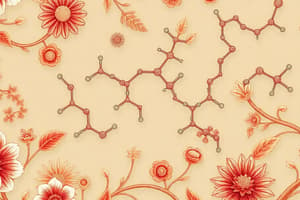Podcast
Questions and Answers
What is the chemical formula for methanol?
What is the chemical formula for methanol?
CH3OH
Which of the following is a common use for alcohol?
Which of the following is a common use for alcohol?
- Fuel
- Solvent
- Reagent
- All of the above (correct)
Ethers are similar in structure to alkanes.
Ethers are similar in structure to alkanes.
True (A)
What is the suffix used to name ethers?
What is the suffix used to name ethers?
What is the general formula for ketones?
What is the general formula for ketones?
What is the suffix used to name carboxylic acids?
What is the suffix used to name carboxylic acids?
Esters are formed by the reaction of a carboxylic acid and an alcohol.
Esters are formed by the reaction of a carboxylic acid and an alcohol.
What are esters commonly used for?
What are esters commonly used for?
Amines are organic compounds containing a nitrogen atom.
Amines are organic compounds containing a nitrogen atom.
What type of bond forms between a metal and a nonmetal?
What type of bond forms between a metal and a nonmetal?
Which of the following properties is typical of ionic compounds?
Which of the following properties is typical of ionic compounds?
What is the main characteristic of covalent bonding?
What is the main characteristic of covalent bonding?
Which statement correctly describes a difference between ionic and covalent compounds?
Which statement correctly describes a difference between ionic and covalent compounds?
What type of bonds can covalent compounds form based on shared electron pairs?
What type of bonds can covalent compounds form based on shared electron pairs?
What is electronegativity a measure of?
What is electronegativity a measure of?
In a polar covalent bond, what occurs to the sharing of electrons?
In a polar covalent bond, what occurs to the sharing of electrons?
Which of the following substances is an example of a polar molecule?
Which of the following substances is an example of a polar molecule?
Which type of intermolecular force is considered the strongest?
Which type of intermolecular force is considered the strongest?
What type of intermolecular force occurs between all molecules?
What type of intermolecular force occurs between all molecules?
Flashcards
Hydroxyl Group
Hydroxyl Group
A functional group consisting of an oxygen atom bonded to a hydrogen atom, represented as –OH.
Carbonyl Group
Carbonyl Group
A functional group containing a carbon atom double-bonded to an oxygen atom, represented as C=O.
Carboxyl Group
Carboxyl Group
A functional group consisting of a carbonyl group and a hydroxyl group attached to the same carbon atom, represented as –COOH.
Alcohol
Alcohol
Signup and view all the flashcards
Ethers
Ethers
Signup and view all the flashcards
Aldehyde
Aldehyde
Signup and view all the flashcards
Ketone
Ketone
Signup and view all the flashcards
Carboxylic Acid
Carboxylic Acid
Signup and view all the flashcards
Esters
Esters
Signup and view all the flashcards
Amines
Amines
Signup and view all the flashcards
Ionic Bond
Ionic Bond
Signup and view all the flashcards
Covalent Bond
Covalent Bond
Signup and view all the flashcards
Ionic Compound
Ionic Compound
Signup and view all the flashcards
Covalent Compound
Covalent Compound
Signup and view all the flashcards
Electron Transfer
Electron Transfer
Signup and view all the flashcards
Electron Sharing
Electron Sharing
Signup and view all the flashcards
Noble Gas Configuration
Noble Gas Configuration
Signup and view all the flashcards
Melting point (ionic)
Melting point (ionic)
Signup and view all the flashcards
Melting point (covalent)
Melting point (covalent)
Signup and view all the flashcards
Polar Covalent Bond
Polar Covalent Bond
Signup and view all the flashcards
Electronegativity
Electronegativity
Signup and view all the flashcards
Polar Covalent Bond
Polar Covalent Bond
Signup and view all the flashcards
Intermolecular Forces
Intermolecular Forces
Signup and view all the flashcards
London Dispersion Forces
London Dispersion Forces
Signup and view all the flashcards
Dipole-dipole Forces
Dipole-dipole Forces
Signup and view all the flashcards
Hydrogen Bonding
Hydrogen Bonding
Signup and view all the flashcards
Polar Molecule Examples
Polar Molecule Examples
Signup and view all the flashcards
Study Notes
Functional Groups
- Hydroxyl group, carbonyl group, carboxyl group are functional groups
- Hydroxyl group includes alcohols and ethers
- Carbonyl group includes aldehydes and ketones
- Carboxyl group includes carboxylic acids, esters, and amines
Hydroxyl Group
- Includes alcohols and ethers
- Alcohols: An organic compound acting as reagent, solvent, or fuel; colorless and transparent; OH group attached to a single bond alkyl group/alkane
- Examples of alcohols: Methanol, Ethanol, Propanol, Isopropanol
- Ethers: Ether structure includes two alkyl groups joined by one oxygen; act much like alkanes. Burn/split apart when boiled in concentrated acids; mostly used as solvents.
- Examples of ethers: Dimethyl ether, Ethylmethyl ether, Methylpropyl ether
Carbonyl Group
- Includes aldehydes and ketones
- Aldehydes: General structure of an aldehyde consists of a carbonyl group with its carbon atom attached to both a hydrocarbon atom and a hydrogen atom; commonly found in essential oils(e.g., cilantro, vanilla)
- Examples of aldehydes: Acetaldehyde, 3-methyl 1-butanal
- Ketones: Characterized by a carbonyl group (O=C) linked to two other carbon atoms; commonly used in perfumes and paints to stabilize other ingredients to prevent quick degradation.
- Examples of ketones: Acetone, 2-butanone
Carboxyl Group
- Includes carboxylic acids, esters, and amines
- Carboxylic acids: Characterized by the presence of a carboxyl group (-COOH); used in the production of polymers, pharmaceuticals, solvents, and food additives
- Esters: Characterized by the presence of a carboxyl group, in which the hydrogen of the hydroxyl group is replaced by an alkyl group; When a carboxylic acid reacts with an alcohol, it forms esters; commonly used as artificial flavorings and fragrances
- Amines: Organic compounds containing a functional group of a basic nitrogen atom; derivatives of ammonia (NH3); when one or more hydrogen atoms are replaced by an R group, the attached alkane chain is named utilizing the suffix "-amine"
Studying That Suits You
Use AI to generate personalized quizzes and flashcards to suit your learning preferences.



